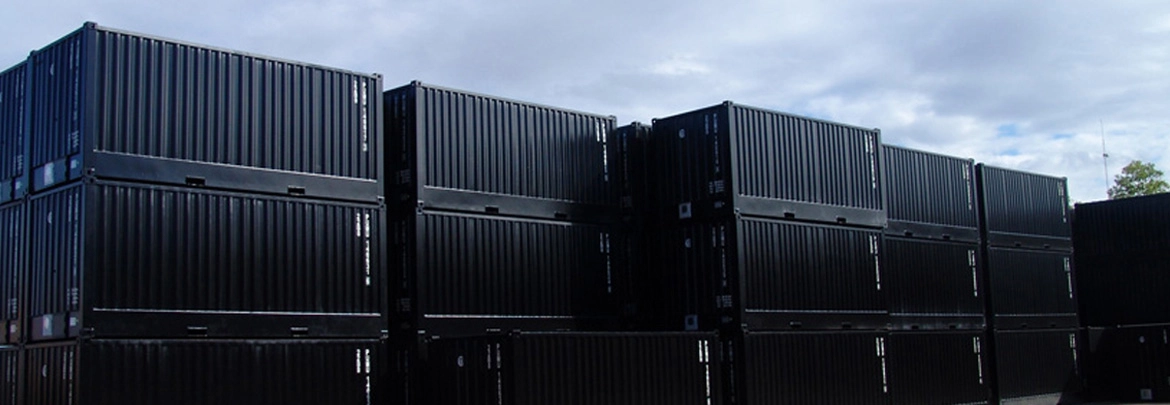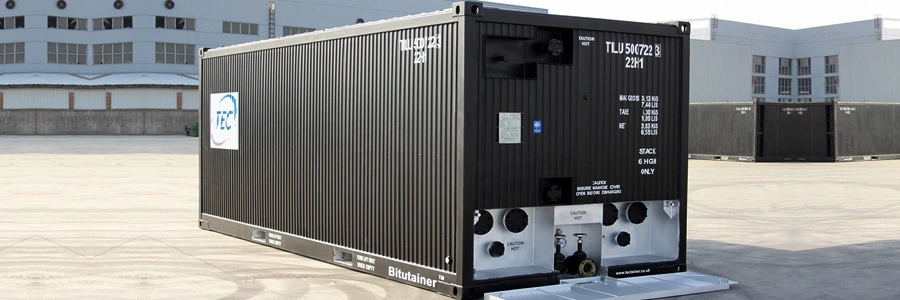 Bitutainer
Bitutainer
WHAT IS BITUTAINER ?
Bitutainer is a specialized container designed for the transportation and storage of bitumen, which is a thick and sticky form of petroleum. The Bitutainer is equipped to handle the unique characteristics of bitumen, providing efficient and safe logistics for this substance. The Bitutainers are suitable for the transportation of bulk bitumen by rail, road and ships throughout the world. All materials used in the construction shall withstand extremes of temperature range from -20°C to 230°C without effecting on the strength of the container. The Bitutainers inside shall be fitted with two pairs of heating pipes running from rear to front and back to rear with exhaust at the top. Heating pipes are fastened by “U” bolts. Diameter of heating pipes is 219mm (at flame area) and 159mm (at other area). Two diesel burners installed at the inlet of each heating pipe will carry out heating.
KEY FEATURES OF A BITUTAINER INCLUDE:
- Insulation: Bitumen needs to be transported and stored at specific temperatures to maintain its viscosity. Bitutainers are often equipped with insulation to control the temperature and prevent the bitumen from solidifying or becoming too viscous.
- Heating System: To ensure that the bitumen remains in a liquid state, Bitutainers often have a heating system. This system can be electric, steam, or thermal oil-based, depending on the design.
- Internal Coating: The container’s interior may be coated with a special material that is resistant to the corrosive nature of bitumen. This coating helps protect the container and ensures the purity of the bitumen during transport.
- Agitators: Bitutainers may have agitators or mixing systems to homogenize the bitumen and prevent it from separating into different components.
- Safety Features: Due to the nature of bitumen, safety features such as pressure relief valves and emergency shut-off systems are often integrated into Bitutainers.
Overall, Bitutainers play a crucial role in the efficient and safe handling of bitumen during its transportation from production facilities to end-users in industries like road construction and roofing. Bitutainer, a widely used term in the bitumen industry, represents a groundbreaking solution for the transportation and intermediate storage of bitumen. Designed with key principles such as high carrying capacity, operator safety, heat efficiency, and durability, the Bitutainer stands out as the optimal choice in bitumen logistics. Particularly in areas lacking shore-based tank terminals, RAHA BITUMEN CO addresses the challenge by supplying bulk bitumen in 20-foot and 40-foot ISO bulk bitumen tank containers. This innovative approach offers a distinctive logistics solution where traditional fixed bulk bitumen storage tanks might not be practical. These Bitutainers, equipped with insulation and heating facilities, efficiently deliver bulk bitumen from depots directly to customer sites. With 30% more carrying capacity than conventional tank containers, the Bitutainer is a unique concept in bitumen distribution, suitable for both storage and transportation of bitumen, bitumen emulsions, PMBs, and heavy fuel oils.
WHAT ARE BITUTAINER OPTIONS
The term “Bitutainer options” refers to the various configurations, features, and specifications available for Bitutainer containers used in the bitumen industry. These options are designed to provide flexibility and cater to specific needs in bitumen transportation and storage. Some common Bitutainer options may include:
- Carrying Capacity: Different Bitutainer models may have varying carrying capacities, allowing users to choose the size that best suits their requirements.
- Insulation: Bitutainers are often equipped with insulation to maintain the temperature of the bitumen during transportation and storage, preventing it from solidifying or losing its desired properties.
- Heating Facilities: Heating elements or systems are essential for maintaining the bitumen’s viscosity and ensuring it remains in a pumpable state. Bitutainers may come with various heating options.
- ISO Container Sizes: Bitutainers are typically designed to ISO standards, with common sizes being 20 feet and 40 feet. The choice of container size depends on factors such as transportation infrastructure and volume requirements.
- Safety Features: Bitutainers may incorporate safety features to protect operators during handling, loading, and unloading. This could include features like secure locking mechanisms and safety signage.
- Valve and Pump Systems: Different Bitutainer models may have variations in their valve and pump systems, allowing users to select the one that aligns with their operational needs.
- Material Construction: Bitutainers may be constructed from various materials, such as stainless steel or carbon steel, depending on factors like durability, weight, and corrosion resistance.
- Customization: Some manufacturers may offer customization options, allowing clients to tailor Bitutainers to their specific requirements, including color, branding, and additional features.
- Compliance with Regulations: Bitutainers should adhere to international regulations and standards for the transportation of hazardous materials. Options may include compliance with safety codes and certifications.
- Cost and Budget Considerations: Different Bitutainer options may come with varying price points, allowing users to select options that fit within their budget constraints.
When considering Bitutainer options, it’s crucial for users to evaluate their specific operational needs, the transportation infrastructure, and regulatory requirements to make informed decisions.
ADVANTAGES OF USING BITUTAINER
The Bitutainer offers several notable advantages in bitumen transportation and storage. With a 30% higher carrying capacity than traditional tank containers, it provides enhanced efficiency and cost-effectiveness. The inclusion of high-performance factory-fitted heating tubes ensures optimal temperature control, while the premium insulation, installed at the factory, adds significant value by preserving the bitumen’s quality during transit. Additionally, the Bitutainer, approved by Lloyd’s, conforms to the standard 20ft ISO container size, offering versatility in shipping. Its robust construction, featuring a durable pressed Corten steel outer skin, makes it suitable for both temporary and long-term storage applications. This innovative container minimizes bitumen loss, ensuring the material’s integrity and resulting in lower freight costs when compared to traditional drums. Overall, the Bitutainer stands out as a reliable and efficient solution for bitumen logistics.
BITUTAINER SPECIFICATION
Suitable for storage and multi-modal transportation of bitumen, bitumen emulsions, polymer modified bitumen’s, waste oils and heavy fuel oils.
A unique concept in bitumen distribution with 30% more carrying capacity than conventional tank containers.
- 20’ft Bitutainer store up to 27 Metric Tons
- 40’ft Bitutainer store up to 65 Metric Tons
- Water capacity 29,000 liters
- Transported as a standard 20ft ISO tank container
- ISO 1496 Part 3 – Type 75 – “Tank Containers”
- Ideal for sea, road and rail transportation
- Design allows partial payloads to be carried (baffled)
- High performance heating systems (8-10°C/hour) via heating tubes (flu pipes)
- High value factory installed insulation with robust outer skin
20’FT BITUTAINER
 20’FT Bitutainer
20’FT Bitutainer
OPTIONAL ACCESSORIES AND AUXILIARY ITEMS:
- Quick fit diesel burners
- Flame/flu pipe liners
- Flexi hoses
- Specialized bitumen pumps
RATINGS
Max Gross Weight: 35,000 Kgs
Payload: 29,000 Kgs
Tare Weight: <6,000 Kgs
MEASURES:
Length: 6058 mm (20’)
Width: 2438 mm (8’)
Height: 2591 mm (8’6”)
FAQ ON TYPICAL BITUTAINERS
Q: Are Bitutainers supplied with heating and handling equipment included?
No, Bitutainers are supplied with factory installed heater tubes but Burner Sets and other equipment is not included.
Q: What are the heating options?
Three options; Direct Fire Diesel or LPG Burners, inserting electric elements into the direct fire heating tubes or by using Thermal Oil from an existing circuit. Direct Fire heating is the most popular option.
Q: How long does it take to heat a full Bitutainer?
Typically it will take 10-11 hours to heat a full Bitutainer (using a 200ltr of diesel) from ambient (approx. 20°C) to pumping temperate (approx. 140°C).
Q: Can 40ft Bitutainer be transported full?
No, 40ft Bitutainers are for storage only. They are not designed or certified for transportation full of product.
Q: Do Bitutainers ship as standard containers?
Yes, they are shipped as standard CSC plated containers
Q: Are Bitutainers suitable for all grades of bitumen?
Yes, Bitutainers are suitable for all grades of bitumen, PMBs and heavy fuel oils. The exception is Coal Tar due to the higher temperatures required for discharge and transfer.
For more information, please Contact our Sales Team.

